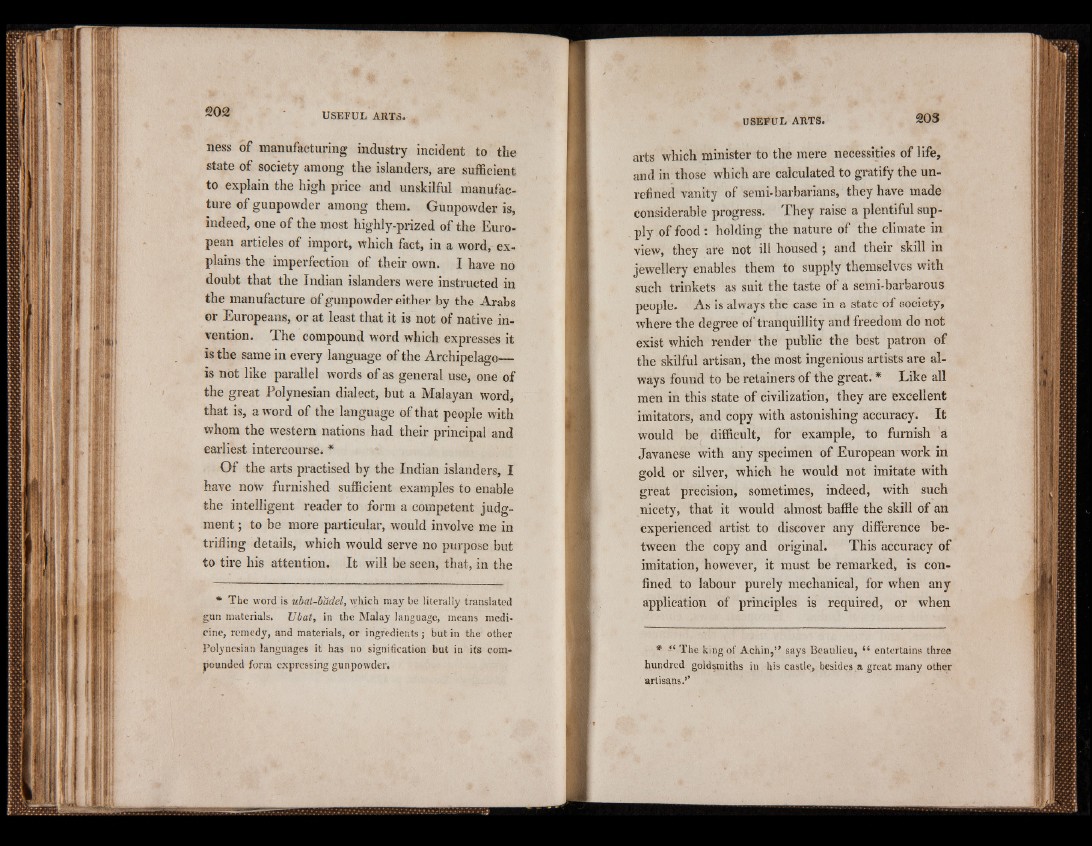
ness of manufacturing industry incident to the
state of society among the islanders, are sufficient
to explain the high price and unskilful manufacture
of gunpowder among them. Gunpowder is,
indeed, one of the most highly-prized of the European
articles of import, which fact, in a word, explains
the imperfection of their own. I have no
doubt that the Indian islanders were instructed in
the manufacture of gunpowder either by the Arabs
or Europeans, or at least that it is not of native invention.
The compound word which expresses it
is the same in every language of the Archipelago—
is not like parallel words of as general use, one of
the great Polynesian dialect, but a Malayan word,
that is, a word of the language of that people with
whom the western nations had their principal and
earliest intercourse* *
Of the arts practised by the Indian islanders, I
have now furnished sufficient examples to enable
the intelligent reader to form a competent judgment
; to be more particular, would involve me in
trifling details, which would serve no purpose but
to tire his attention. It will be seen, that, in the
* The word is ubat-badel, which may be literally translated
gun materials. Ubat, in the Malay language, means medicine,
remedy, and materials, or ingredients; but in the other
Polynesian languages it has no signification but in its compounded
form expressing gunpowder.
arts which minister to the mere necessities of life,
and in those which are calculated to gratify the unrefined
vanity of semi-barbarians, they have made
considerable progress. They raise a plentiful supply
of food: holding the nature of the climate in
view, they are not ill housed ; and their skill in
jewellery enables them to supply themselves with
such trinkets as suit the taste of a semi-barbarous
people. As is always the case in a state of society,
where the degree of tranquillity and freedom do not
exist which render the public the best patron of
the skilful artisan, the most ingenious artists are always
found to be retainers of the great. * Like all
men in this state of civilization, they are excellent
imitators, and copy with astonishing accuracy. It
would be difficult, for example, to furnish a
Javanese with any specimen of European work in
gold or silver, which he would not imitate with
great precision, sometimes, indeed, with such
nicety, that it would almost baffle the skill of an
experienced artist to discover any difference between
the copy and original. This accuracy of
imitation, however, it must be remarked, is confined
to labour purely mechanical, for when any
application of principles is required, or when
* fi The king of Achin,” says Beaulieu, t{ entertains three
hundred goldsmiths in his castle, besides a great many other
artisans.’’